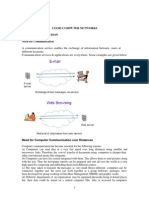EVOLUTION OF NETWORKS
➢ SHORT STORY :
When the computer came into the world, that has a lot demand, and a computer really
deserves it. The computer programmers started to code a system to do some
operations. In a while, there is no way to share data from one machine to another. They
face an issue to code for each computer. To overcome the issue, the system designers
think, how to connect two computers ?
• After a long research they found to connect the computers with a cables.
• The cable is useful to transfer up to 10kb/s.
• Since the data transfer time and data is in enormous amount, that’s not adequate
to
• Transfer data frequently.
• Now the Topology came into to action to connect number of computers to make
data transfer easy and to make the network to stay connected.
• With the topology, the wires also get updated.
• Likely,
Twisted pair, Coaxial
The topology is a structure to connect network more efficient as possible.
“ This makes the network to transfer data frequently “
❖ NEED OF A NETWORK :
� • A network is a set of devices (often referred to as nodes) connected by
communication links. A node can be a computer, printer, or any other device
capable of sending and/or receiving data generated by other nodes on the
network.
• The system was simply not advanced in one day; rather took a long time to be an
all the more incredible, productive and dependable system.
• Advancement of systems administration began path back in 1969’s by the
improvement of first system called ARPANET, which prompted the
improvement of web.
❖ DISTRIBUTED PROCESSING :
• Most networks use distributed processing, in which a task is divided among
multiple computers. Instead of one single large machine being responsible
for all aspects of a process, separate computers (usually a personal
computer or workstation) handle a subset.
❖ ARPANET(ADVANCED RESEARCH AGENCY NETWORK):
“ ARPANET was the network that became the basis for the Internet “
• It was the first network that came into existence in 1969, which was
designed and named by the Advanced Research Projects Agency (ARPA) and
US Department of Defence (DoD).
• It was where a bunch of PCs were associated at various colleges and US DoD
for sharing of information and messages and associating with individuals to
share their perspectives.
A. NSFNET (NATIONAL SCIENCE FEDERATION NETWORK):
• In mid 80’s another federal agency, NSFNET (National Science Federation
Network) created a new network which was more capable than ARPANET and
became the first backbone infrastructure for the commercial public Internet.
• Its main aim was to use network only for academic research and not for any
kind of private business activity. Later, many privately owned businesses with
2
� their very own private systems joined with ARPANET and NSFNET to make
more capable and wide network, the Internet.
ARPANET + NSFNET + PRIVATE NETWORKS = INTERNET
B. EXPANSION: LANs, WANs, AND THE WORLD WIDE WEB
✓ Local Area Networks (LANS) :
• In the 1980s and 1990s, networking expanded into businesses and
educational institutions.
• LANs connected computers within a limited area such as a building or
campus.
- Ethernet became the standard technology for LANs.
- LANs allowed users to share files, printers, and software applications.
✓ Wide Area Networks (WANs) :
• WANs connected LANs across large distances, enabling nationwide and
international communication.
- Technologies like leased lines, frame relay, and ATM were used in WANs.
- The rise of telecom networks made WANs widely accessible.
C. CONCLUSION :
The evolution of computer networks has reshaped our world, from simple
connections in research labs to a global infrastructure that drives commerce,
communication, and innovation. Understanding this evolution provides valuable
insight into the technologies we use today and those that will define tomorrow.
As we continue to move into a more connected, digital era, the role of computer
networks will only become more critical. For students and professionals alike,
studying this evolution is not just academic — it’s essential.
























































































